
No. 133 (August 2020)

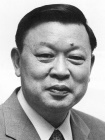 Michiyoshi Harasawa |  |
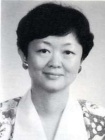 Wan-Cheng Tan |  |
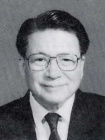 Wei-Ci Luo |  |
 Ann Janet Woolcock |  |
 Shiro Kira |  |
 Wah-Kit Lam |  |
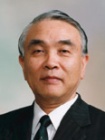 Yoshinosuke Fukuchi |  |
 Norbert Berend |  |
 YoungSoo Shim |  |
 Mary S-M Ip |  |
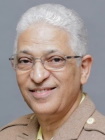 Arth Nana |  |
 Michiaki Mishima |  |
 Kwun Fong |  |
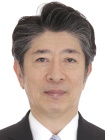 Yoichi Nakanishi |  |
 who do you nominate next? |
Members are now invited to nominate the next APSR President-Elect. Self-nomination also possible.
The President-Elect's term is one year, from November 2020 to November 2021. Thereafter he or she will become APSR President for the next two years.
The deadline for receiving applications from nominees is 9 August 2020 so your nominations must be submitted very soon.
This is a unique chance for members to nominate who should lead the Society and also an opportunity to put themselves forward for the position.
Full details and how to nominate are at: apsresp.org/archive/president-elect-nominations-2020.html
See a collection of COVID-19 material on the dedicated COVID-19 page on the APSR website.
Respirology Case Reports, Volume 08 Issue 6
Respirology Case Reports, Volume 08 Issue 7
The spotlight this month is on
Each month we share details of activities of a particular country, region or society.
If you would like the spotlight to be on your country, region or society next month, contact the Bulletin Coordinator or APSR Secretariat.
An APSR-PCCP Joint Symposium was held during the 39th Annual Chest Convention of the Philippine College of Chest Physicians (PCCP) on 4 March 2020 at Edsa Shangrila, Manila, Philippines.
As with all En Bloc Society - APSR Joint Symposia half of the lectures were presented by the En Bloc Society and half from the APSR.
Programme:
| 4 March 2020 11:00-11:30 Master plenary session 4 |
President's session • Malbar G Ferrer, MD, FPCCP (PCCP) • Kwun Fong, MD (APSR) • Mark Elliott, MD (BTS) |
| 6 March 2020 10:20-10:50 Master plenary session 9 |
Advances in lung cancer - diagnosis & treatment • Kwun Fong, MD |
Dr Fong reports:
It was a privilege and honour to represent the APSR at the outstanding PCCP 39th Annual Chest Convention: 3-6 March 2020 in Manila with a very interesting theme of "CLARITY: Concepts, Lessons, Advances and Realities in the year 2020".
The Local Organising Committee did a remarkable job and delivered a very high quality meeting full of scientific and educational content. Congratulations and thanks to them and the PCCP for strengthening the close relationship with the two Societies.
It was a 3-day programme with Plenaries, Meet the Masters, Exhibits, Oral and poster presentations, intertwined with official functions and social events. The PCCP is renowned for delivering quality research and education while extending collegiate and networking opportunities, and this was fully evident at "Clarity". The full majesty and formality of the Opening Ceremony with an Honour Lecture by Dr Jennifer Ann Mendoza-Wi set the scene for a wonderful Convention.
The Plenaries included topics on the Big 5 of lung disease; asthma, COPD, infection, lung cancer and TB, with excellent speakers from local, regional, national and international sources. Technological innovations were impressive with live streamed presentations including on the topic COVID-19 soon to be pandemic.
The interhospital debates were robust and served to showcase new talent which bodes well for respiratory medicine in the Philippines.
Well done PCCP members, keep up your remarkable work and help us all in the Asia-Pacific region reach out and help our communities achieve the good lung health that we all deserve. Salamat.
The PCCP reports:
As launched in the APSR Hanoi last November 2019, the Philippine College of Chest Physicians (PCCP) immediately applied for the innovative project "Joint APSR - En bloc Society Symposium", as an added feature in our annual meeting scheduled on 3-6 March 2020 in Manila, Philippines. We were honoured to have Prof. Kwun M Fong, the immediate past president of the APSR, as the faculty who represented the Society in our meeting.
Prof. Fong's first symposium was the Presidents' Session where along with the two other panelists, Dr Malbar Ferrer, incumbent president of the PCCP and Dr Mark Elliott, immediate past president of the British Thoracic Society (BTS), discussed on how the different respiratory societies can collaborate and work together to address the biggest challenges facing the medical field right now. The session, facilitated by Dr Patrick Moral, a member of the APSR Education Committee, tackled climate change, COVID-19, the opportunities and dangers of social media in respiratory medicine, approach to diverse organizations in terms of culture and the societies impact in members' clinical practice. Prof. Fong shared a notable message for the societies to work things locally and achieve globally.
Another Joint APSR-PCCP Symposium conducted was the plenary session on "Advances in Lung Cancer Diagnosis and Treatment" where Prof. Fong presented the current approach to diagnosis and treatment options for lung cancer.
As an offshoot of the successful 2020 PCCP CLARITY Annual Chest Convention, another great initiative was launched by the APSR, the APSR-PCCP Travel Award in APSR Congress. Maiden conferment was originally planned for the 2020 Kyoto APSR Congress, derailed by the current pandemic.
The PCCP conveys its sincerest gratitude to the Executive Committee of the Asian Pacific Society of Respirology for giving us the opportunity to host these significant sessions. The convention was an unqualified success as measured by attendance and quality of the scientific programme.
(Click any image to enlarge)
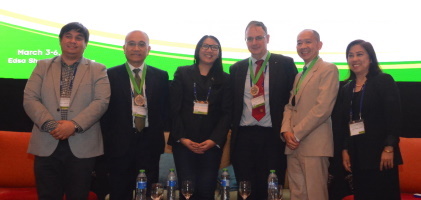
To hold a joint APSR session with your own respiratory society, see apsresp.org/education/joint-symposium.html
The date has changed for the World Congress of Bronchology & Interventional Pulmonology (WCBIP), biennial flagship international congress of the WABIP (World Association of Bronchology & Interventional Pulmonology).
This had been scheduled to be held in Shanghai, China, on 16-19 April 2020 and has been postponed to 24-27 September 2020 due to the coronavirus pandemic.
Please check the WABIP webpage www.wabip.com/congress for the latest details.
The date has changed for the 60th Annual Meeting of the Japanese Respiratory Society
This had been scheduled to be held in Nagoya on 24-26 April 2020 and has been postponed to 20-22 September 2020 due to the coronavirus pandemic. The venue has also been changed and the Annual Meeting will now be held at the Kobe Convention Center, Japan.
Please check the JRS webpage www.jrs.or.jp/jrs60/en/index.html for the latest details.
Due to the pandemic, the date of the World Conference on Lung Cancer has changed.
This had been scheduled to be held on 9-12 August 2020 and has been postponed to 26-29 January 2021.
Please check the IASLC website wclc2020.iaslc.org for the latest details.
Tokyo, 1 August 2020
In support of World Lung Cancer Day, the Forum of International Respiratory Societies (FIRS), of which the APSR is a founding member, calls for more awareness and understanding of lung cancer risk factors, as well as the importance of early screening and treatment.
Lung cancer is responsible for nearly 1 in 5 cancer deaths according to the World Health Organization. While lung cancer and breast cancer are diagnosed at the same rate (11.6 percent), lung cancer kills more people yearly than breast, colon and prostate cancers combined. Lung cancer mortality is projected to reach 2.45 million by 2030, a 39 percent increase in just over a decade.
While most understand that smoking is the single greatest risk factor for lung cancer at 80 percent of all cases, other lesser known risk factors include the environment and genetics. Environmental exposure to radon, asbestos, arsenic, beryllium and uranium has been linked to lung cancer. The risk of lung cancer also increases with a history of cancer in another part of the body, age, family history, radiation to the chest area and lung diseases like chronic obstructive pulmonary disease (COPD).
Access to screening options and education is vital for early detection and treatment. Low-income countries, where survival rates are significantly below the average, report only a 15 percent availability of treatment through public health systems. More that 90 percent of high-income countries report vital access to care.
Lung cancer symptoms include change in mucus, chest or back pain, coughing up blood and difficulty swallowing. Tests that may be used to diagnose lung cancer include chest x-rays, CT and PET scans, bronchoscopy and needle biopsies. If you are a current or former smoker and over the age of 55, you may be a candidate for a low-dose CT scan screening that can potentially detect lung cancer in its earliest stages.
About the Forum of International Respiratory Societies (FIRS)
Click any of the images above to enlarge (poster size) and copy for your activities.
You can also click any of the blank templates below for creating posters with your own message. Feel free to add your society logo at the bottom.
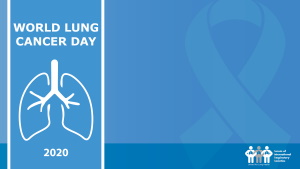 |
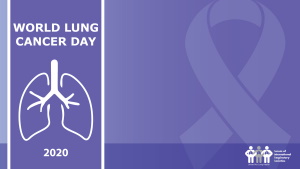 |
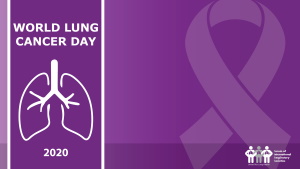 |
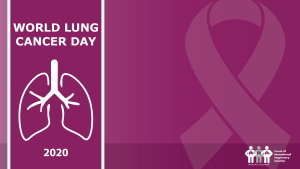 |
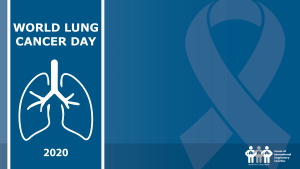 |
Lung cancer: the most fatal cancer
Treating lung cancer
Advance notice for your preparations for World Lung Day on 25 September
The Forum of International Respiratory Societies (FIRS) have prepared a series of fliers in different languages.
Click any image to enlarge and copy.

The Teaching Library is open for your self-study. Challenging yourself to choose the correct procedure for any of the 111 cases in the Library at apsresp.org/education/teaching-library/index.php.
Many more cases are needed for this Library and any member is welcome to submit a case through the same link as above.
The following article has recently been selected from Respirology for its specific educational value. Previous articles on further topics can be seen at apsresp.org/education/articles/index.html
Of special interest to those working in:
* Sleep
* Pulmonary circulation
* Clinical Respiratory Medicine
Periodic limb movements during sleep and blood pressure changes in sleep apnoea: Data from the European Sleep Apnoea Database Carolina Lombardi; Gianfranco Parati; Davide Soranna; Antonella Zambon; Paweł Sliwinski; Gabriel Roisman; Jean-Louis Pepin; Sophia Schiza; Renata Riha; Pavol Joppa; Ingo Fietze; Jan Hedner; Ludger Grote; the European Sleep Apnoea Database (ESADA) Collaborators (DOI: 10.1111/resp.13760)
onlinelibrary.wiley.com/doi/10.1111/resp.13760/full (May 2020)
Comment by Dr Mark Lavercombe:
The association between obstructive sleep apnoea and cardiovascular disease is well recognised. In this paper, the authors explore the role of comorbid elevation of the periodic limb movements in sleep index in a cohort of of patients with obstructive sleep apnoea, and demonstrate a significant elevation in systolic blood pressure, even after accounting for the degree of OSA with multivariate analysis. Further studies - including those utilising 24h BP monitoring - are recommended.
The following members have kindly sent their donation towards the Society's goals, as outlined at apsresp.org/members/donors.php.
The APSR is profoundly grateful for their generosity.

Dr Song, Head of the APSR Respiratory Infections (non-tuberculous) Assembly, has been invited to participate in ATS Virtual 2020 5-10 August 2020, along with other experts representing the ATS, ERS, ALAT and PATS.
There will be two 90-minute sessions 'Global Review on COVID-19':
5 August at 08:30 (US Eastern Time)
10 August at 08:30 (US Eastern Time)
For the start times and further details see ATS Virtual 2020.
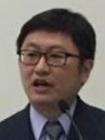

Dr Tatsuma Fukuda will present during the session 'New insights into mechanical ventilation in the intensive care unit' on 7 September at 09:30-10:30.
Dr Shu-Yung Lin will present during the session 'Tuberculosis' on 8 September at 14:30-15:30.
Congratulations to both members and we are confident their presentations of their work will be greatly appreciated by their audiences.
Congratulations to the following members who have recently become Fellows of the APSR:
A warm welcome to the following members who have recently joined or re-joined APSR assemblies.
| Harender Singh Chaudhary | Clinical Respiratory Medicine Tuberculosis Clinical Allergy & Immunology |
| Chi-Li Chung | Clinical Respiratory Medicine Lung Cancer Interstitial Lung Disease |
| Laxmi Devi | Clinical Respiratory Medicine Tuberculosis Asthma |
| Andrew Charles Frean | Environmental & Occupational Health and Epidemiology Respiratory Infections (non-tuberculous) Asthma |
| Mansoor Hameed | Asthma Clinical Respiratory Medicine COPD |
| Rahul Jalan | Bronchoscopy and Interventional Techniques Tuberculosis Interstitial Lung Disease |
| Niranjan Chandrama Lehupe Bandarage | Clinical Respiratory Medicine Interstitial Lung Disease Respiratory Infections (non-tuberculous) |
| Abdullah Mobeireek | Clinical Respiratory Medicine Respiratory Infections (non-tuberculous) Respiratory Infections (non-tuberculous) |
| Avinash Murugan | Bronchoscopy and Interventional Techniques Critical Care Medicine Interstitial Lung Disease |
| Manju Rajaram | Clinical Respiratory Medicine Cell and Molecular Biology Interstitial Lung Disease |
| Venkateswara Babu Ranganathan | Clinical Allergy & Immunology COPD Asthma |
| Krishna K Sharma | Pulmonary Circulation Interstitial Lung Disease Bronchoscopy and Interventional Techniques |
| Anoma Siribaddana | Interstitial Lung Disease Environmental & Occupational Health and Epidemiology Respiratory Neurobiology and Sleep |
| Rishikesavan Suntharalingam | Respiratory Neurobiology and Sleep Lung Cancer Interstitial Lung Disease |
| Mahesh Babu Vemuri | Clinical Respiratory Medicine Respiratory Infections (non-tuberculous) Interstitial Lung Disease |
| Sugeesha Wickramasinghe | Clinical Respiratory Medicine Critical Care Medicine Interstitial Lung Disease |
| Siti Chandra Widjanantie | Environmental & Occupational Health and Epidemiology Respiratory Structure and Function COPD |
| Rex Chin-wei Yung | Critical Care Medicine Lung Cancer Bronchoscopy and Interventional Techniques |
Here are the main respiratory events in Asia-Pacific region for the next few months. You can see our full listing on the APSR Calendar.
For more pulmonology events, see apsresp.org/calendar.html
(These events are for information only and APSR endorsement should not be assumed.)
If you have news of interest to APSR members, please send details to one of the Bulletin Coordinators: Prof. A Azuma (a-azuma@nms.ac.jp) or Prof. C K Rhee (chinkook77@gmail.com).